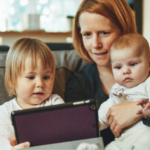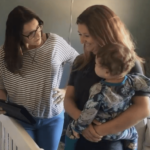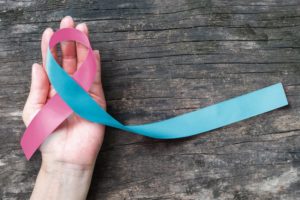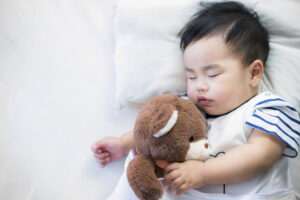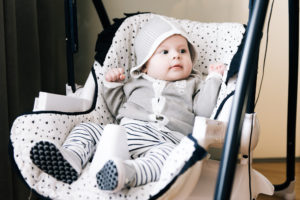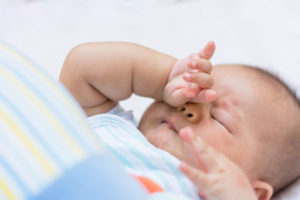When you buy through our links, we may earn a commission. Products or services may be offered by an affiliated entity. Learn more.
When Can Babies Start Sleeping on Their Stomachs?
- Place babies on their backs to sleep for at least the first year.
- Placing babies on their stomachs too soon increases risk of SIDS.
- Supervised tummy time during waking hours is essential for a baby’s development and motor skills.
The first years of a child’s life are full of new developments for both the child and the parents, from adjusting to an infant’s sleep cycle to the joys of a baby that sleeps through the night. One milestone that caregivers are often curious about is when an infant can safely begin sleeping on their stomach, which experts recommend delaying until a child turns 1 year old .
Sleep position affects an infant’s health and safety. Therefore it is important for caregivers to understand the proper sleep position for a baby, as well as other measures they can take to create a safe and comfortable sleep environment.
Experts recommend infants should sleep only on their backs until they reach 1 year of age. Back sleeping is the safest position for infants because it reduces the risk for sudden infant death syndrome (SIDS). When a child reaches 1 year old they can begin sleeping on their stomach or in another position.
Is It Safe for Babies to Sleep on Their Stomach?
Putting an infant under 1 year old to sleep on their stomach is not recommended by healthcare experts. Instead of allowing an infant to sleep on their stomach or side, the American Academy of Pediatrics recommends that caregivers place infants on their back until the child is at least 1 year of age. This recommendation applies to all types of sleeping, including daytime naps. After a child turns 1 year old, there is no need to make sure they sleep only on their back .
While stomach sleeping is not advised for most infants, there may be some children for whom the risks of sleeping on their stomach are outweighed by the benefits. Caregivers should discuss questions or concerns about sleeping position with their child’s pediatrician.
SIDS and SUID
Stomach sleeping is a considerable risk factor for sudden infant death syndrome (SIDS). The term is applied to events when an apparently healthy infant unexpectedly dies , usually during sleep. SIDS is the most common cause of death for infants between 1 month and 1 year old. Most SIDS deaths occur before an infant is 6 months old.
Doctors do not know the exact cause of SIDS, but research has revealed several factors that increase an infant’s risk. While experts believe that sleeping position is the most important risk factor for SIDS, other risk factors include:
- Sleeping on soft surfaces, like couches, chairs, or mattresses designed for adults
- Sleeping with blankets and other bedding that is soft or loose
- Overheating during sleep
- Exposure to cigarette smoke in the bedroom, car, or other places
- Sleeping in the same bed as caregivers, other children, or pets
Help Your Baby Sleep Better With Pediatric Sleep Coaching

our partner at sleepdoctor.com
Learn More“Life-changing! My anxiety about my son’s sleeping habits were immediately reduced after talking to Sara. She went above and beyond to tailor a schedule to our goals, answer our questions, keep us on track, and check in to encourage us when we just thought we couldn’t do it anymore.”
Rachael B. – Verified Customer
What to Do if Your Baby Rolls Onto Their Stomach During Sleep
As infants grow, they become more mobile. Caregivers may notice a child learning to roll from their back to their stomach when they are between 4 and 6 months old . If a child rolls onto their stomach during sleep, caregivers do not need to adjust the infant’s position. Simply begin each night with the child sleeping on their back and in a safe sleep environment free from blankets and other soft or loose objects.
Is It OK to Put Your Baby Down on Their Stomach?
Placing a baby on their stomach during supervised playtime encourages healthy development. “Tummy time” helps babies develop strength and motor skills for future milestones, such as rolling, crawling, and eventually walking. Time spent on the stomach also helps prevent a child from developing flat spots on the back of their head.
Experts recommend that babies get at least 30 minutes of tummy time during the day. Caregivers can begin with short periods of 3 to 5 minutes a few times throughout the day. As a child grows to enjoy tummy time, these periods can be extended. Keep in mind that tummy time involves a watchful caregiver and is not recommended as a sleep position for infants.
Talking to the Doctor About Your Baby’s Sleeping Position
Regular visits to a pediatrician can ensure that a child is achieving the appropriate developmental milestones throughout their first year of life. During these appointments, caregivers can ask the healthcare provider any questions they have regarding their baby’s sleeping position. Doctors can offer recommendations based on a child’s individual needs.
How to Prevent Your Baby From Developing Flat Spots on the Head
Some caregivers may be concerned that putting a baby to sleep on their back can lead to the development of flat spots on the baby’s head. However, there are a few steps caregivers can take to prevent these flat spots from developing.
- Tummy time: Give a child plenty of playtime on their stomach.
- Sleeping direction: Each week, switch the direction a child lies on their mattress.
- Reduce time in seats: Limit the use of seats that put pressure on the back of a child’s head, such as carriers and bouncy seats.
- Hold an infant upright: Spend time holding a child in an upright position while they are awake.
If the development of flat spots on a child’s head is a concern, caregivers should consult with their pediatrician for additional advice.
Safe Sleep Tips for Babies
In addition to putting an infant to sleep on their back for their first year, there are other safety tips that parents and caregivers can take into account to keep a child safe and comfortable during sleep.
Create a Safe Sleep Space
A firm, safety-approved sleep surface like a crib or bassinet ensures that an infant gets the appropriate support they need. The infant’s mattress can be covered by a fitted sheet. However, toys, pillows, blankets, bumper pads, and any other soft objects or bedding are not recommended in an infant’s sleep environment.
Some products for infants, such as cribs and mattresses, are marketed with the claim that they reduce the risk of SIDS. To date, there are no commercial products that can prevent SIDS, and experts suggest avoiding any product that contradicts safe sleeping recommendations.
Sleep in the Same Room as Your Infant
The American Academy of Pediatrics recommends that infants should sleep in the same room as the caregiver, on a separate surface, for the first year after birth. Research has found that a child sleeping in the same room as parents can reduce the risk of SIDS by up to 50%.
Caregivers may bring their infant into an adult bed for feeding or playtime. Before doing so, make sure to clear bedding and any soft items from the area. Once feeding or playtime is over, it is important to move the infant back into their separate sleeping area.
Avoid Exposing an Infant to Secondhand Smoke
Smoking during and after pregnancy is associated with a variety of infant health issues , including premature births, birth defects, and SIDS. Experts recommend that caregivers not smoke while pregnant or after their child’s birth in order to keep the infant’s environment smoke-free.
Offer a Pacifier During Sleep Time
Research has demonstrated that offering an infant a pacifier before naps and nighttime sleep can protect against SIDS by as much as 90%. Infants can be introduced to pacifiers right away, although parents who breastfeed should wait around 3 to 4 weeks until a baby is established with breastfeeding.
If a child does not want a pacifier before sleeping, caregivers should not force them to use it. Additionally, if the pacifier falls out during sleep it is not necessary to wake the child or put the pacifier back into the child’s mouth. Keep in mind that the pacifier should not be attached to clothing or blankets and should be free of any items that may be hazardous to the child during sleep, such as soft toys or strings.
Keep an Appropriate Temperature
Overheating due to clothing, blankets, or room temperature increases the risk of SIDS . Infants should wear light clothing or a wearable blanket designed for sleep. No blankets or other soft, loose objects should be needed to keep an infant warm . Remember to always keep an infant’s face and head uncovered while sleeping.
Although there is not an exact bedroom temperature recommended for infants, rooms should be around 65ºF and comfortable for an adult in light clothing. Caregivers can monitor a child’s temperature by looking for sweating or a warm chest, both of which are signs of overheating.

Still have questions? Ask our community!
Join our Sleep Care Community — a trusted hub of sleep health professionals, product specialists, and people just like you. Whether you need expert sleep advice for your insomnia or you’re searching for the perfect mattress, we’ve got you covered. Get personalized guidance from the experts who know sleep best.
References
15 Sources
-
Moon, R. Y., Darnall, R. A., Feldman-Winter, L., Goodstein, M. H., & Hauck, F. R. (2016). SIDS and other sleep-related infant deaths: Evidence base for 2016 updated recommendations for a safe infant sleeping environment. Pediatrics, 138(5).
https://pubmed.ncbi.nlm.nih.gov/27940805/ -
National Institute of Child Health and Human Development. (2007). Infant sleep position and SIDS: Questions and answers for health care providers.
https://www.nichd.nih.gov/sites/default/files/publications/pubs/documents/SIDS_QA-508-rev.pdf -
A.D.A.M. Medical Encyclopedia. (2019, August 7). Sudden infant death syndrome. MedlinePlus.
https://medlineplus.gov/ency/article/001566.htm -
Raab, C. P. (2021, August). Sudden infant death syndrome (SIDS). Merck Manual Consumer Version.
https://www.merckmanuals.com/home/children-s-health-issues/miscellaneous-disorders-in-infants-and-young-children/sudden-infant-death-syndrome-sids -
National Institute of Child Health and Human Development. (n.d.). Fast facts about SIDS.
https://safetosleep.nichd.nih.gov/safesleepbasics/SIDS/fastfacts -
National Institute of Child Health and Human Development. (n.d.). Known risk factors for SIDS and other sleep-related causes of infant death.
https://safetosleep.nichd.nih.gov/safesleepbasics/risk/factors -
National Institute of Child Health and Human Development. (n.d.). Frequently asked questions (FAQs) about SIDS and safe infant sleep.
https://safetosleep.nichd.nih.gov/safesleepbasics/faq -
National Institute of Child Health and Human Development. (n.d.). Babies need tummy time!
https://safetosleep.nichd.nih.gov/safesleepbasics/tummytime -
Hewitt, L., Kerr, E., Stanley, R. M., & Okely, A. D. (2020). Tummy time and infant health outcomes: A systematic review. Pediatrics, 145(6).
https://pubmed.ncbi.nlm.nih.gov/32371428/ -
National Center for Chronic Disease Prevention and Health Promotion, Division of Reproductive Health. (2021, September 27). Helping babies sleep safely. Centers for Disease Control and Prevention.
https://www.cdc.gov/reproductivehealth/features/baby-safe-sleep/index.html -
Eunice Kennedy Shriver National Institute of Child Health and Human Development (NICHD). (n.d.). Ways to Reduce The Risk Of SIDS And Other Sleep-Related Causes Of Infant Death.
https://safetosleep.nichd.nih.gov/safesleepbasics/risk/reduce -
National Center for Chronic Disease Prevention and Health Promotion, Office on Smoking and Health. (2022, February 8). Smoking, pregnancy, and babies. Centers for Disease Control and Prevention.
https://www.cdc.gov/tobacco/campaign/tips/diseases/pregnancy.html -
Corwin, M.J.. (2021, December 14). Sudden infant death syndrome: Risk factors and risk reduction strategies. In G. B. Mallory, S.M. Misra (Eds.). UpToDate.
https://www.uptodate.com/contents/sudden-infant-death-syndrome-risk-factors-and-risk-reduction-strategies -
Corwin, M.J.. (2021, March 22). Patient education: Sudden infant death syndrome (SIDS) (beyond the basics). In S.M. Misra (Eds.). UpToDate.
https://www.uptodate.com/contents/sudden-infant-death-syndrome-sids-beyond-the-basics -
National Institutes of Health. (2014, December 15). Unsafe infant bedding use still common.
https://www.nih.gov/news-events/nih-research-matters/unsafe-infant-bedding-use-still-common



